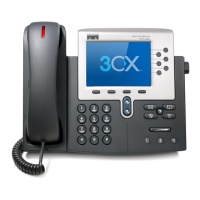Usage NotesPurposeNetwork Protocol
DHCP is enabled by default. If disabled,
you must manually configure the IP
address, subnet mask, gateway, and a
TFTP server on each phone locally.
Cisco recommends that you use DHCP
custom option 150. With this method,
you configure the TFTP server IP address
as the option value. For additional
supported DHCP configurations, see
“Dynamic Host Configuration Protocol”
and “Cisco TFTP” chapters in the
Cisco Unified Communications Manager
System Guide.
DHCP dynamically allocates and
assigns an IP address to network
devices.
DHCP enables you to connect an IP
Phone into the network and have the
phone become operational without you
needing to manually assign an IP
address or to configure additional
network parameters.
Dynamic Host
Configuration Protocol
(DHCP)
Cisco Unified IP Phones use HTTP for
the XML services and for troubleshooting
purposes.
Cisco Unified IP Phones do not support
the use of IPv6 addresses in the URL.
You cannot use a literal IPv6 address in
the URL or a hostname that maps to an
IPv6 address.
HTTP is the standard way of
transferring information and moving
documents across the Internet and the
web.
Hypertext Transfer
Protocol (HTTP)
Web applications with both HTTP and
HTTPS support have two URLs
configured. Cisco Unified IP Phones that
support HTTPS choose the HTTPS URL
out of the two URLs.
Hypertext Transfer Protocol Secure
(HTTPS) is a combination of the
Hypertext Transfer Protocol with the
SSL/TLS protocol to provide
encryption and secure identification of
servers.
Hypertext Transfer
Protocol Secure
(HTTPS)
The Cisco Unified IP Phones implement
the IEEE 802.1X standard by providing
support for the following authentication
methods: EAP-FAST, EAP-TLS, and
EAP-MD5.
When 802.1X authentication is enabled
on the phone, you should disable the PC
port and voice VLAN.
The IEEE 802.1X standard defines a
client-server-based access control and
authentication protocol that restricts
unauthorized clients from connecting
to a LAN through publicly accessible
ports.
Until the client is authenticated, 802.1X
access control allows only Extensible
Authentication Protocol over LAN
(EAPOL) traffic through the port to
which the client is connected. After
authentication is successful, normal
traffic can pass through the port.
IEEE 802.1X
Cisco Unified IP Phone 7941G, 7941G-GE, 7942G, 7961G, 7961G-GE, and 7962G Administration Guide for Cisco Unified
Communications Manager 9.0 (SCCP and SIP)
7
Cisco Unified IP Phone
Network Protocols

